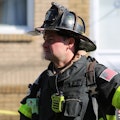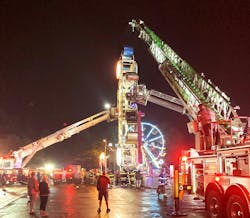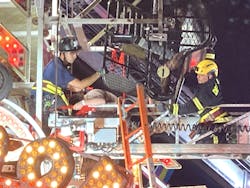Tech Rescue: Carnival & Amusement Park Rides: Thinking Outside of the Box
Thinking outside of the box is a concept that every competent firefighter and rescuer should be able to do under some form of stress. Whether that stressor is fire showing from several windows or a vehicle in a precarious position with victims trapped, we all do our best to train for that moment when we must perform in a fraction of a second.
What about the annual carnival that comes into your jurisdiction or into a local mutual-aid department’s town? I would wager that many among you either were detailed to stand by or took a ride with the crew to the local carnival for some positive public relations. What happens when an incident occurs on the premises? Did you and your fellow members discuss what to do in such a circumstance?
On the other side of the coin, what about when something happens at a fixed facility, such as a corporate amusement park that’s open every day. You can’t operate on the presumption that nothing will happen. By the laws of the universe, it’s a matter of when, not if.
Thinking outside of the box is necessary to mitigate an incident that involves matters beyond the norm.
Traveling carnival or fixed location
The first thing that must be discussed is the location of the attraction and its type (traveling carnival or amusement park).
In the case of a traveling carnival, does it utilize a church’s rear parking lot? Does it use the rear remote ballfields of a public school? The location of a traveling carnival is important, because, after all, you must understand how you will get responders, equipment and apparatus in and out of the scene.
In the case of a traveling carnival that comes to town annually, you must understand the ingress and egress points and the limitation of your apparatus. (Hopefully, the layout of the carnival rides doesn’t change much year to year.)
Part of preplanning might be to work with the carnival company to ensure that the tallest ride is located in an area where the aerial apparatus is capable of being set up and of accessing the highest point of the ride. Eliminating that concern before game day allows you and fellow members to focus on other variables that might present during an incident.
In the event that you will operate at a fixed facility, such as an amusement park or a local attraction, hopefully, your fire prevention and building department can provide you with information and connections to prepare for an incident.
One key difference between the two types is the overall structural quality of the attractions. Fixed-location rides are engineered to be permanent, while rides that are at traveling carnivals are portable, which means that they are assembled and disassembled frequently. The majority of the latter are trailered across regions and, thus, are subject to additional wear and tear from exposure to the weather and from being moved around.
Chief officers and those who deal with planning the response to these incidents must look at both potentials. One can consider this in the same vein as when discussing fires in houses that have roofs of legacy construction or toothpick towers with trusses that were bounced around across the country and sat in mud before they were assembled.
Secondary injuries
A second important factor to ponder is the potential magnitude of an incident that occurs at a traveling carnival or an amusement park. More people in an area translates to more potential issues. The more people that are in the area around the rides, the more potential for secondary injuries should there be a catastrophic failure of the equipment. This means that there’s more potential for triage concerns and, simply, more potential for delays in getting personnel and equipment to where they must go.
Nondepartmental resources
To combat these concerns, establish an incident action plan early and use the unified model to get input from everyone who should be involved. Law enforcement is experienced in crowd control. EMS is experienced in treating patients. Firefighters are experienced at mitigating technical tangible problems. If you work together, things should go smoothly.
In the event that an incident at a traveling carnival requires technical rescue resources, make those connections prior to opening night exposure. It can be something as simple as a phone call to reach out to your mutual-aid companies to say, “If something happens, you will be dispatched,” or it can be a well-developed, monthly mutual-aid training.
An important component that always comes up during conversation is interoperability. Interoperability is important not only to radio communications but also equipment and tactics. If you don’t have the same ways or can’t justify the investment to standardize, at a minimum, understand how both units operate. That can be as simple as understanding the uses and differences between two brands of ropes and associated hardware.
Rides & associated injuries
There are several hazards when dealing with emergencies that involve carnival and amusement park rides, including, but not limited to, electrocution, crush, pinch and impalement. If a child or adult gets stuck in a unique manner, it’s your responsibility to give that individual the best chance of getting out of that situation. Investment is required to make that happen, whether it’s purchasing apparatus and equipment, training, stipends, insurance or payroll.
When bad things happen, nobody wants to be standing around contemplating whether they should be there. When it’s time to do hero things, you must be able to operate.
Take a moment to think about traveling carnivals that you attended. Which rides were the quintessential attractions? The Zipper? The Zero Gravity? The Ring of Fire? The small-scale rollercoaster? The two-story potato sack slide? The latter might be the simplest attraction at a traveling carnival, but it poses a fall and collapse concern. As rescuers, if you were to operate at an incident that involves issues with the slide, you might need to think outside of the box to stabilize, to search and rescue under the structure.
Take that same attraction and simplify the incident: a medical emergency at the top of the slide. How do you access and remove the patient from the top? Climb the ladder or switch back stairs on the scaffolding and then Stokes the patient down with ropes or an aerial?
Even a simple slide might require technical skills when it comes to stabilization and the removal process.
The Zipper is a rotating boom that has 12 enclosed cars on a second cable track that rotates independently while the boom is in motion. At its peak height in the vertical orientation, the ride measures approximately 60 feet. Each car holds as many as three people. The car door is secured by a double-action latch. Now, imagine this ride located behind a church and it stalls in a precarious position. What are you doing? How are you locking and tagging out the movement and power sources? Is the operator/attendant actively attempting to help, or did that person run off? You have as many as 36 riders stressing out as you approach the scene. Do you have the capabilities to reach the top car at 60-some feet up? Is that aerial capable of taking on those riders? Are your firefighters/rescuers trained to climb to the peak to stabilize the rocking car and to unlock the jammed door to assist with securing and moving the panicked parties?
All that said, this scenario is relatively simple. It doesn’t involve any physical trauma to a rider nor a catastrophic failure of the equipment. Consider, instead, the heightened stressors of a single-track loop ride and a car full of riders that stalled upside down in the center of the loop. In addition to the basic steps of mitigating a machinery emergency, you must adapt and overcome patients having additional issues because of being upside down and all of their weight on the lock safety mechanism of each seat. If there isn’t a way to release the car back to the bottom of the track, what will you do? Is the aerial available to get underneath the car? Do you break out the ropes and harnesses to engage a rope rescue operation?
Size up & analyze
The key takeaways from this column are to keep it simple, don’t forget the basics and develop an understanding of what mitigation entails when you deal with incidents that involve traveling carnival and fixed-location amusement park rides. Size up and break down the issue. Is someone stuck in a section of the ride? Is someone stuck in a precarious position? Did the attraction structurally fail, collapse and trap staff and patrons around it?
Make contact with the operator of the attraction. Make contact with the patients. Come up with a game plan and execute that plan. Stabilize. Rescue. Remove.
About the Author

Robert Policht
Robert Policht, who is a Firehouse contributing editor, is lieutenant of Ladder Co. 2 of the Passaic, NJ, Fire Department. He assisted with developing and establishing the department’s response to human vs. machine incidents and is attached to the Fire Investigation Unit. Policht started his career as a volunteer and has served as a chief of department. He taught at the Bergen County, NJ, Fire Academy and is a member of the NJ Division of Fire Safety's Fire Threat Task Force. Policht has a master’s degree in emergency management and homeland security from Arizona State University and has been published in several trade publications. He is a founder of and contributor to Flow and Vent, which is a website that's dedicated to fire and rescue training.

